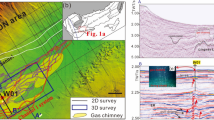Abstract
Nuclear magnetic resonance measurements in hydrate-bearing sandstone samples from the Shenhu area, South China Sea were used to study the effect of gas hydrates on the sandstone permeability. The hydrate-bearing samples contain pore-filling hydrates. The data show that the pore-filling hydrates greatly affect the formation permeability while depending on many factors that also bear on permeability; furthermore, with increasing hydrate saturation, the formation permeability decreases. We used the Masuda model and an exponent N = 7.9718 to formulate the empirical equation that describes the relation between relative permeability and hydrate saturation for the Shenhu area samples.
Similar content being viewed by others
References
An, X. P., Li, X. F., Cheng, S. Q., Wang, Z. W., and Liu, S. M., 2005, Comparative analysis for permeability acquired from different methods: Well Testing (in Chinese), 14(5), 14–17.
Chen, F., Zhou, Y., Su, X., Liu, G. H., Lu, H. F., and Wang, J. J., 2011, Gas hydrate saturation and its relation with grain size of the hydrate-bearing sediments in the Shenhu Area of northern South China Sea: Marine Geology & Quaternary Geology (in Chinese), 31(5), 95–100.
Coates, G. R., Peveraro, R. C. A., Hardwick, A., and Roberts, D., 1991, The magnetic resonance imaging log characterized by comparison with petrophysical properties and laboratory core data: The SPE 71th Annual Technical Conference and Exhibition, Dallas, SPE 22723.
Kenyon, W. E., 1992, Nuclear magnetic resonance as a petrophysical measurement: Nucl. Geophys., 6(2), 152–171.
Kleinberg, R. L., Flaum, C., Griffin, D. D., Brewer, P. G., Malby, G. E., Peltzer, E. T., and Yesinowski, J. P., 2003, Deep Sea NMR: methane hydrate growth habit in porous media and its relationship to hydraulic permeability, deposit accumulation and submarine slope stability: Journal of Geophysical Research, 108(B10), 2508–2524.
Kumar, A., Maini, B., Bishnoi, P. R., Clarke, M., Zatsepina, O., and Srinivasan, S., 2010, Experimental determination of permeability in the presence of hydrates and its effect on the dissociation characteristics of gas hydrates in porous media: Journal of Petroleum Science and Engineering, 70, 114–122. 17(4), 37–40.
Li, C. H., Feng, K., and Liu, X. W. 2013, Study on p-Wave Attenuation in Hydrate-Bearing Formation Based on BISQ model: Journal of Geological Research, doi:10.1155/2013/176579.
Liang, H., Song, Y., Chen, Y., and Liu, Y., 2011, The measurement of permeability of porous media with methane hydrate: Petroleum Science and Technology, 29(1), 79–87.
Liu, Y., Chen, W., Song, Y. C., Yang, M. J., Li, Q. P., and Yu, X. C., 2011, Experimental and theoretical study of permeability character of sediments containing methane hydrates: Journal of Dalian University of Technology (in Chinese), 51(6), 793–797.
Masuda, Y., Naganawa, S., and Ando, S., 1997, Numerical calculation of gas production performance from reservoirs containing natural gas hydrates: The SPE 73rd Annual Technical Conference and Exhibition, San Antonio, SPE 38291.
Minagawa, H., Egawa, K., Sakamoto, Y., Komai, T., Tenma, N., and Narita, H., 2012, Characterization of hydraulic permeability and pore-size distribution of methane hydrate-bearing sediment using proton nuclear magnetic resonance measurement: International Journal of Offshore and Polar Engineering, 22(4), 306–313.
Minagawa, H., Nishikawa, Y., Ikeda, I., Miyazaki, K., Takahara, N., Sakamoto, Y., Komai, T., and Narita, H., 2008, Relation between permeability and pore-size distribution of methane-hydrate-bearing sediments: Offshore Technology Conference, Houston, Texas, USA.
Moridis, G., Apps, J., Pruess, K., and Myer, L., 1998, EOSHYDR: a tough2 module for CH4-hydrate release and flow in the subsurface: LBNL Report No. 42386.
Parker, J. C., Lenhard, R. J., and Kuppusamy, T., 1987, A parametric model for constitutive properties governing multiphase flow in porous media: Water Resource Research, 23(4), 618–624.
Sakamoto, Y., Kakumoto, M., Miyazaki, K., Tenma, N., Komai, T., Yamaguchi, T., Shimokawara, M., and Ohga, K., 2009, Numerical study on dissociation of methane hydrate and gas production behavior in laboratory-scale experiments for depressurization: Part 3—Numerical study for estimation of permeability in methane hydrate reservoir: International Journal of Offshore and Polar Engineering, 19(2), 124–134.
Sakamoto, Y., Komai, T., Kawamura, T., Minagawa, H., Tenma, N., and Yamaguchi, T., 2007, Laboratory-scale experiment of methane hydrate dissociation by hotwater injection and numerical analysis for permeability estimation in reservoir: Part 1—Numerical study for estimation of permeability in methane hydrate reservoir: International Journal of Offshore and Polar Engineering, 17(1), 47–56.
Sakamoto, Y., Komai, T., Kawamura, T., Minagawa, H., Tenma, N., and Yamaguchi, T., 2007, Modification of permeability model and history matching of laboratory-scale experiment for dissociation process of methane hydrate: Part 2—Numerical study for estimation of permeability in methane hydrate reservoir: International Journal of Offshore and Polar Engineering, 17(1), 57–66.
Song, Y. C., Huang, X., Liu, Y., and Yang, M. J., 2010, Experimental study of permeability of porous medium containing methane hydrate: Journal of Thermal Science and Technology (in Chinese), 9(1), 51–57.
Spangenberg, E., 2001, Modeling of the influence of gas hydrate content on the electrical properties of porous sediments: Journal of Geophysical Research: Solid Earth, 106(B4), 6535–6548.
Wang, G. H., and Li, G. M., 2001, Analysis of the method and principles of determining permeability with NMR logging: Well-Logging Technology (in Chinese), 25(2), 101–104.
Zhao, Q., Dunn K.J., and Liu, X. W., 2011, A simulation study of formation permeability as a function of methane hydrate concentration: Applied Geophysics, 8(2), 101–109.
Author information
Authors and Affiliations
Corresponding author
Additional information
This study was supported by the Key Program for International S &T Cooperation Projects of China (No.2010DFA21630) and the National Natural Science Foundation of China (No.41306050).
Li Chuan-Hui received his MS (2012) at China University of Petroleum (East China). Currently, he is a PhD student at China University of Geosciences (Beijing). His research interests are in the field of gas hydrates recognition.
Rights and permissions
About this article
Cite this article
Li, CH., Zhao, Q., Xu, HJ. et al. Relation between relative permeability and hydrate saturation in Shenhu area, South China Sea. Appl. Geophys. 11, 207–214 (2014). https://doi.org/10.1007/s11770-014-0432-6
Received:
Revised:
Published:
Issue Date:
DOI: https://doi.org/10.1007/s11770-014-0432-6




